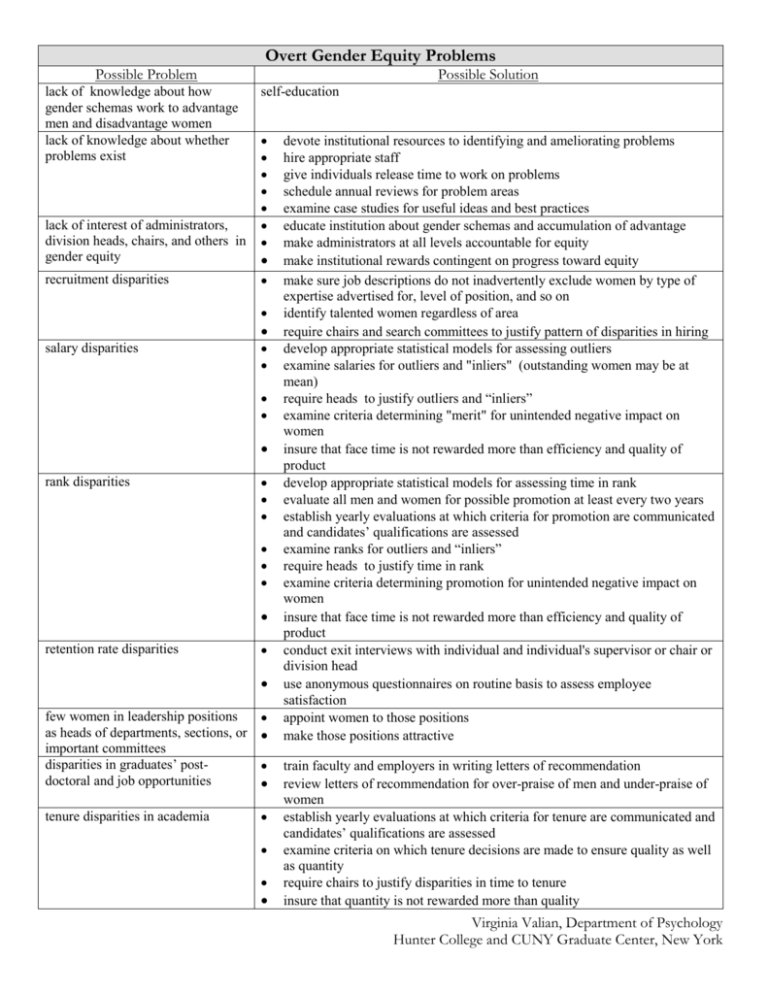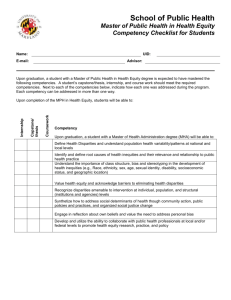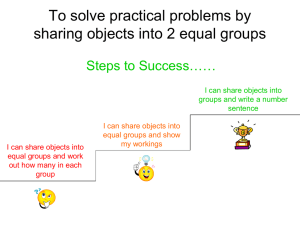Overt Gender Equity Problems
advertisement

Overt Gender Equity Problems Possible Problem lack of knowledge about how gender schemas work to advantage men and disadvantage women lack of knowledge about whether problems exist lack of interest of administrators, division heads, chairs, and others in gender equity recruitment disparities Possible Solution self-education salary disparities rank disparities retention rate disparities few women in leadership positions as heads of departments, sections, or important committees disparities in graduates’ postdoctoral and job opportunities tenure disparities in academia devote institutional resources to identifying and ameliorating problems hire appropriate staff give individuals release time to work on problems schedule annual reviews for problem areas examine case studies for useful ideas and best practices educate institution about gender schemas and accumulation of advantage make administrators at all levels accountable for equity make institutional rewards contingent on progress toward equity make sure job descriptions do not inadvertently exclude women by type of expertise advertised for, level of position, and so on identify talented women regardless of area require chairs and search committees to justify pattern of disparities in hiring develop appropriate statistical models for assessing outliers examine salaries for outliers and "inliers" (outstanding women may be at mean) require heads to justify outliers and “inliers” examine criteria determining "merit" for unintended negative impact on women insure that face time is not rewarded more than efficiency and quality of product develop appropriate statistical models for assessing time in rank evaluate all men and women for possible promotion at least every two years establish yearly evaluations at which criteria for promotion are communicated and candidates’ qualifications are assessed examine ranks for outliers and “inliers” require heads to justify time in rank examine criteria determining promotion for unintended negative impact on women insure that face time is not rewarded more than efficiency and quality of product conduct exit interviews with individual and individual's supervisor or chair or division head use anonymous questionnaires on routine basis to assess employee satisfaction appoint women to those positions make those positions attractive train faculty and employers in writing letters of recommendation review letters of recommendation for over-praise of men and under-praise of women establish yearly evaluations at which criteria for tenure are communicated and candidates’ qualifications are assessed examine criteria on which tenure decisions are made to ensure quality as well as quantity require chairs to justify disparities in time to tenure insure that quantity is not rewarded more than quality Virginia Valian, Department of Psychology Hunter College and CUNY Graduate Center, New York Hidden Gender Equity Problems Possible Problem Possible Solution lack of awareness of likelihood of overvaluing men and undervaluing women unequal office space unequal laboratory space unequal access to internal research funds unequal access to technical and computer assistance unequal access to secretarial and research assistance unequal access to specialized equipment learn about gender schemas and accumulation of advantage criteria for success not communicated equally to young men and women criteria for success too narrow some practices have inadvertent disproportionate impact unequal mentoring of women and men failure to highlight women’s and men’s accomplishments equally failure to legitimate women as leaders in their field more effort made to groom men for stardom in field more nominations of men than women for prizes, to journal boards, and to steering committees of major professional organizations lack of understanding of reward structure of organization interview highly successful individuals to determine what resources they draw upon create surveys of all staff to determine their knowledge and use of each resource where support staff is not equally responsive to males and females, require log of requests and date requests are filled rectify space inequities where knowledge is lacking, create handbook to inform staff of resources where equipment gatekeepers are not equally responsive to males and females, require gatekeepers to keep log of requests and date requests are filled interview highly successful and less successful individuals to determine what information they receive and in what contexts they receive it create surveys of all staff to determine their knowledge of criteria and attempts to meet them require chairs to communicate criteria explicitly develop informal channels of communication for women that are parallel to those for men identify unheralded contributions that improve quality of institution include such contributions as criteria interview perceptive staff about practices that generally seem to limit the institution; these are likely to have diversity consequences as well attempt to eliminate such practices identify known good mentors; interview for mentoring techniques teach senior staff how to mentor; inform mentors about likely imbalances identify occasions on which staff can be given positions of leadership (e.g., presentations to important outsiders (trustees, stockholders, and so on) ensure equal representation of males and females identify women who are outstanding and promote their professional development develop workshops for students, post-docs, and junior staff explaining structure of organization (whether corporate, governmental, or academic), operation of gender schemas, and effective strategies for professional development Virginia Valian, Department of Psychology Hunter College and CUNY Graduate Center, New York Strategies for Women Group action Identify allies, male as well as female Work with institutional allies at all levels Examine successful programs from elsewhere, with awareness of cross-institutional differences Identify problem areas for women Identify reasons for institution to commit to change Obtain institutional commitment to and resources for change Negotiate for release time and other resources in order to develop solutions Be strategic Pay continuing attention Individual action Indicate willingness to be nominated for important prizes and positions Become successful outside the institution Nominate women for important prizes and positions Build power by performing jobs that are out of the ordinary, visible, and relevant to current institutional problems Learn what resources are available and necessary Learn how to negotiate Negotiate Seek information about criteria for success men receive much information informally; hard to be successful by accident Make allies and find sponsors Help others, especially women, with information and resources Be impersonal - less distracting, less feminine Be friendly and respectful - takes sting out of competence and effectiveness Recognize that you can do everything “right” and still fall behind Virginia Valian, Department of Psychology Hunter College and CUNY Graduate Center, New York Strategies for Men As leaders Examine successful programs from elsewhere, with awareness of cross-institutional differences Identify reasons for institution to commit to change (e.g., will help solve institutional problems) Develop accountability within institution for gender equity Explicitly identify women and men who should be groomed for leadership positions Identify areas where gender equity is likely to be a problem Identify men and women who can work successfully for gender equity; reward them for doing so Supply institutional commitment to and resources for change Pay continuing attention Reward leaders with a record of helping women and men equally Communicate information about criteria for success within and outside institution men receive much information informally; hard to be successful by accident Nominate women and men equally for important prizes and positions within and outside the institution Solicit comments and suggestions from women and men equally Listen to women’s and men’s suggestions equally Ensure equal participation of women and men in public settings Assign responsibilities to women that are out of the ordinary, visible, and relevant to current institutional problems As colleagues Make eye contact with women when they are speaking to you Nod when women make valuable points Solicit and listen to women’s suggestions Talk about your work with female as well as male colleagues Pass along information equally to female and male colleagues Ally with women on issues of common interest Virginia Valian, Department of Psychology Hunter College and CUNY Graduate Center, New York Justifications for Insuring Gender Equity in Universities Gender equity: Increases likelihood of valuable innovations (innovations require diverse group of people) Maximizes chances of hiring best new faculty by increasing candidate pool (females likely to be slightly more talented than males) Maximizes quantity and quality of work of all faculty by ensuring equal salary, equal promotion, equal access to resources in both fact and appearance Creates stronger and more viable institution via fairness reputation (demonstrations of fairness and concern for fairness build loyalty) Establishes reputation as gender-equitable institution Virginia Valian, Department of Psychology Hunter College and CUNY Graduate Center, New York








